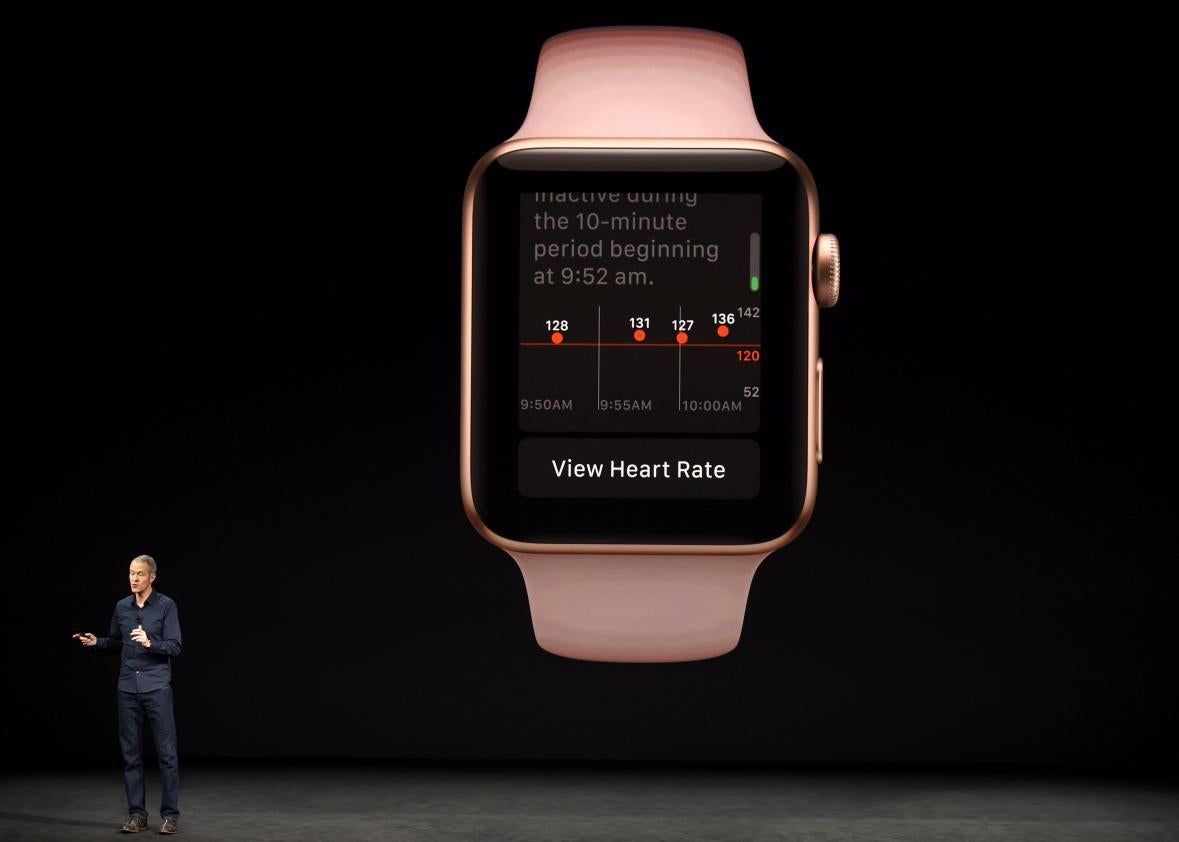The Apple Watch has a new trick: connecting to workout machines at the gym. Announced back at Apple’s Worldwide Developer Conference in June, this capability—called GymKit—syncs Apple Watches with smart gym equipment. It’s a step beyond what even today’s most advanced GPS and activity monitors offer—and a step toward turning the Apple Watch into the ultimate fitness tracker.
With GymKit, when you step onto a compatible treadmill or elliptical, you simply tap your watch against the machine and the two are paired; the machine’s display mirrors what’s on your wrist, and the specific stats tracked by the machine are relayed to your watch. By syncing them up, you get a more complete picture of your workout, including more accurate calorie burn estimates—and with less effort, as your watch already has your height and weight information. At the moment, GymKit is only available at one gym in New York, but in 2018 it will roll out in Equinox facilities across the country. Over time, the connected platform will also integrate with machines from companies including Cybex, Life Fitness, Matrix, Schwinn, Stairmaster, Star Trac, and TechnoGym at other chains, too.
When the Apple Watch launched in 2015, many were lukewarm about the device as a comprehensive fitness tracker. It lacked GPS, it wasn’t waterproof, and its activity tracking was basic at best. Fast forward two years and the watch’s fitness-focused capabilities have improved significantly. In the Series 3, which debuted in September, you get both GPS tracking and cellular connectivity. And since 2016’s Series 2, the Apple Watch has been swim proof, with built-in pool and open water swim tracking.
But plenty of devices excel at outdoor exercise monitoring. Garmin, Polar, Lezyne, and other manufacturers make bike computers, smartwatches, and activity trackers optimized for capturing everything from your swimming stroke and heel strikes to mapping the exact trails you pedaled through on a mountain bike. Once you head indoors, though, their utility shrinks. While my Garmin Forerunner 920XT, for example, offers an indoor mode for running and cycling, the indoor cycling mode, in particular, is only useful in noting that I worked out in the first place—and perhaps guesstimating my calorie burn if I wore a heart rate monitor, too. It certainly can’t track intricacies like the cadence stats on my spin bike. (To be fair, a growing number of Bluetooth-connected gym machines do make it easier to sync your workout stats with a corresponding app on your phone, even if your expensive GPS watch doesn’t.)
With its gym connectivity, Apple steps beyond what these smartwatches and fitness trackers offer. One of the few existing devices designed to tackle that realm, the Garmin Vívosmart 3, ended up being more hassle than help, according to one reviewer. The device, which has a rep-counting feature targeted at weight lifters, was often inaccurate with its counting, and you still needed to manually label what sort of weight-lifting exercise you were doing in-app. By connecting directly to cardio machines, the Apple Watch negates some of those issues: As CNET notes in its hands-on review of GymKit, workout data is sent to your Apple Watch, then saved on your phone, labeled by the equipment brand used. Workout data may include heart rate, calorie burn, pace, elevation, and stairs climbed, depending on the machine.
There are still a couple of issues athletes may have with making the Apple Watch their main activity tracker. One notable problem: It’s still troublesome to export workouts to other apps, such as Training Peaks or Strava. There is a relatively painless workaround, though: The workout manager app RunGap, which connects with Apple’s platform and lets you export activities to other third-party apps with a $1.99 in-app purchase. However, if Apple truly wants to get serious about making the Apple Watch a leading fitness tracker, it’ll eventually need to make activity sharing with third-party apps as seamless as everything else about the experience.
Battery life is also an issue—my Garmin can last upwards of 12 hours, but for those whose workouts regularly tend towards 4 hours or more, the Apple Watch could eventually die on you. Its wrist-based heart rate tracking, while generally accurate, isn’t always as exact as a chest-worn heart rate strap, particularly if you’re doing interval training. And in general, if you want pinpoint accurate GPS tracking, or a more rugged device because you’re scrambling through rocks and sand, a high-end GPS watch will better suit your needs.
Still, with its beefed up outdoor activity handling and its integration with indoor gym equipment, the Apple Watch is proving to be a formidable fitness watch appropriate for both casual exercisers and more serious athletes.
